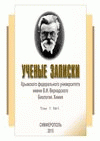Yalta, Simferopol, Russian Federation
The article presents the results of a study of the mass fraction and component composition of essential oil obtained from the above-ground mass of rose-scent geranium (Pelargonium graveolens L’Hér.), grown in open ground conditions on the Southern Coast of the Crimea (SCC). P. graveolens is a species of the genus Pelargonium, a combined Geraniaceae, naturally produced in the Cape Floristic Region and widely cultivated throughout the world as a valuable ornamental, essential oil and medicinal plant. The essential oil was obtained by hydrodistillation using Ginsberg apparatus. The component composition of essential oils was determined using a hardware and software complex based on a chromatograph “Chromatek-Crystal 5000.2” equipped with a mass spectrometric detector. Identification was performed based on a comparison of the obtained mass spectra with data from the NIST 14 library (National Institute of Standards and Technology, USA). “MS Search” spectrum search and identification program (USA). Retention indices were obtained by logarithmic interpolation of the presented retention times using the analytical standard of a mixture of reference n-alkanes “Sigma-Aldrich” (Switzerland) and analytical standards “Supelco” (USA). The mass fraction of components in the sample was determined by the percentage normalization method. The mass fraction of EOs in freshly collected raw materials is 0.22 % and 1.33 % in terms of absolutely dry weight. The essential oil is represented by 41 components, 87.8 % of which have been identified. Based on the results of chromatographic analysis, it was established that the quantitatively predominant components of the EO of the studied sample of P. graveolens under the conditions of the SCC are: terpene alcohols: citronellol – 39.67 %, geraniol – 13.61 % and terpene ether – citronellyl formate 10.58 %. The EO sample was characterized by a small amount of undesirable components, such as isomenthone (5 %) and a complete absence of 10-epi-udesmol and menthone. By this composition, the EO obtained under the conditions of the SCC is close to samples, produced from raw materials grown in China, Armenia and Tajikistan. The results obtained allow us to consider P. graeolens for the conditions of the SCC as a promising source of natural essential oils of domestic production for the needs of pharmaceutical, perfumery, cosmetics and food industries.
Pelargonium graveolens L’Hér., essential oil, mass fraction, component composition, Southern Coast of the Crimea.
1. Gutieva N. M. Atlas of large-flowered pelargonium varieties that are promising for the subtropics of the Russian Federation, 100 p. (Sochi: Federal Scientific Research Center of the Russian Academy of
2. Rabotyagov V. D., Paliy A. E., Kurdyukova O. N. Essential oils of aromatic plants. 208 p. (Simferopol: IT “Arial”, 2018). (in Russ.).
3. Singh P., Khan S., Kumar S., Rahman L. Plant Cell, Tissue and Organ Culture (PCTOC), 129 (1), 35 (2017). DOI:https://doi.org/10.1007/s11240-016-1153-8 EDN: https://elibrary.ru/WKOIIN
4. Peterson A., Machmudah S., Roy B. C., Goto M., Sasaki M., Hirose T. Extraction of essential oil from geranium (Pelargonium graveolens) with supercritical carbon dioxide. Journal of Chemical Technology
5. Filippova A. A., Szhenova T. M., Golovina N. V., Garnova N. Yu., Bokov D. O. Standardization of geranium essential oil. Bulletin of Moscow University. Ser. 2. Chemistry, 61(3), 249 (2020). (in Russ.).
6. Lis-Balchin M., Geranium and pelargonium. The genera Geranium and Pelargonium, 116 (Taylor & Francis London: CRC Press, 2002.
7. Abe S., Maruyama N., Hayama K., Inouye S., Oshima H., Yamaguchi H. Suppression of neutrophil recruitment in mice by geranium essential oil. Mediators of Inflammation, 13, 21 (2004).
8. Ananthan R., Latha M., Ramkumar K. M., Pari L., Baskar C., Narmatha BMV. Modulatory effects of Gymnema montanum leaf extract on alloxan-induced oxidative stress in Wistar rats. Nutrition, 20, 280 (2004).
9. Maruyama N., Sekimoto Y., Ishibashi H., Inouye S., Oshima H., Yamaguchi H., Abe S. Suppression of neutrophil accumulation in mice by cutaneous application of geranium essential oil. Journal
10. Silva N. C., Fernandes A. J. Biological properties of medicinal plants: a review of their antimicrobial activity. Journal of Venomous Animals and Toxins Including Tropical Diseases, 16, 402 (2010).
11. Edwards-Jones V., Buck R., Shawcross S. G., Dawson M. M., Dunn K. The effect of essential oils on methicillin-resistant Staphylococcus aureus using a dressing model. Burns, 30(8), 772 (2004).
12. Carmen G., Hancu G. Antimicrobial and antifungal activity of Pelargonium roseum essential oils. Advanced Pharmaceutical Bulletin, 4(2), 511. (2014).
13. Giongo J. L., Vaucher R., Borin D. I., Correa M. S., Dos Santos V. B., Santos R. C., Boligon A. A., Athayde M. L., Bonez P. C., Rossi G. G., De Campus M. M. Antimycobacterial, antimicrobial and
14. Narnoliya L. K., Jadaun J. S., Singh, S. P. The Phytochemical Composition, Biological Effects and Biotechnological Approaches to the Production of High-Value Essential Oil from Geranium. In: Malik, S.
15. Rath C. C., Dash S. K., Rao B. R. Antifungal activity of rose-scented geranium (Pelargonium species) essential oil and its six constituents. Journal of Essential Oil Bearing Plants, 8(2), 218 (2005).
16. Rosato A., Vitali C., Gallo D., Balenzano L., Mallamaci R. The inhibition of Candida species by selected essential oils and their synergism with amphotericin B. Phytomedicine, 15, 635 (2008).
17. Bouzenna H., Krichen L. Pelargonium graveolens L’Her. and Artemisia arborescens L.essential oils: chemical composition, antifungal activity against Rhizoctonia solani and insecticidal activity against
18. Naeini A. R., Nazeri M., Shokri H. Antifungal activity of Zataria multiflora, Pelargonium graveolens and Cuminum cyminum essential oils towards three species of Malassezia isolated from patients with
19. Shin S., Lim S. Antifungal effects of herbal essential oils alone and in combination with ketoconazole against Trichophyton spp. Journal of Applied Microbiology, 97, 1289 (2004).
20. Lis-Balchin M. Aromatherapy science: A guide for healthcare professionals, 112 (London: Pharmaceutical Press, 2006).
21. Mohamed N. B., Abdelkrim K., Fairouz S. Essential oil of Algerian rose-scented geranium (Pelargonium graveolens): Chemical composition and antimicrobial activity against food spoilage pathogens. Food
22. Seo S. M., Kim J., Lee S. G., Shin C. H., Shin S. C., Park I. K. Fumigant antitermitic activity of plant essential oils and components from Ajowan (Trachyspermumammi), Allspice (Pimentadioica), caraway
23. Sabzghabaee A. M., Shirdare Z., Ebadian B., Aslani A., Ghannadi A. Clinical evaluation of the essential oil of Pelargonium graveolens for the treatment of denture stomatitis. Dental Research Journal, 1, 105 (2011).
24. Ponomareva E. I., Molokhova E. I., Kholov A. K. Identification of components of essential oil of fragrant geranium (Pelargonium graveolens L'H.) by thin layer chromatography. Chemistry for sustainable
25. Shevchuk O. I., Isikov V. P., Logvinenko L. A. Methodological and methodological aspects of the introduction and selection of aromatic and medicinal plants / Ed. editor, corresponding member RAS
26. Adams R. P. Identification of essential oil compounds by gas chromatography/quadrupole mass spectroscopy. – Allured Pub. Corp., USA, 2007. – 804 p.
27. Tkachev A.V. Study of plant volatile substances, 969 (Novosibirsk: “Ofset”, 2008). (in Russ.).
28. Marko N.V., Logvinenko L.A., Shevchuk O.M., Feskov S.A. Annotated catalog of aromatic and medicinal plants from, 176 (Simferopol: IT “ARIAL”, 2018). (in Russ.).
29. Azonov D. A., Kholov A. K., Razykova G. V. The healing properties of Geranoretinol and essential oils, 156 (Tashkent: Matbuot Publishing House, 2011). (in Russ.).
30. Babu K. G., Kaul V. K. Variation in essential oil composition of rose-scented geranium (Pelargonium sp.) distilled by different distillation techniques. Flavour and Fragrance Journal, 20(2), 222 (2005).
31. Kholov A. K., Azonov D. A. Essential oil plants and essential oils – sources of biologically active substances (literature review). Bulletin of the Tajik National University (scientific journal) series of
32. Priscila L. Santos, Joo Pedro S. C. F. Matos, Laurent Picot, Jackson R. G. S. Almeida, Jullyana S. S. Quintans, Lucindo J. Quintans-Jnior. Citronellol, a monoterpene alcohol with promising pharmacological
33. Qneibi M., Jaradat N., Emwas N. Effect of Geraniol and Citronellol Essential Oils on the Biophysical Gating Properties of AMPA Receptors. Applied Sciences, 9(21), 4693.
34. Jayaraj R. L., Azimullah S., Parekh K. A., Ojha S. K., Beiram R. Effect of citronellol on oxidative stress, neuroinflammation and autophagy pathways in an in vivo model of Parkinson's disease.
35. Gonzalez-Audino P., Picollo M.I., Gallardo A., Toloza A., Vassena, C., MougabureCueto G. Comparative toxicity of oxygenated monoterpenoids in experimental hydroalcoholic lotions to permethrin-
36. Michaelakis A., Vidali V. P., Papachristos D. P., Pitsinos E. N., Koliopoulos G., Couladouros E. A., Polissiou M. G., Kimbaris A. C. Bioefficacy of acyclic monoterpenes and their saturated derivatives against the
37. Zore G. B., Thakre A. D., Rathod V., Karuppayil S. M. Evaluation of anti-Candida potential of geranium oil constituents against clinical isolates of Candida albicans differentially sensitive to
38. Mączka W., Wińska K., Grabarczyk M. One Hundred Faces of Geraniol. Molecules, 21;25(14), 3303 (2020). DOI:https://doi.org/10.3390/molecules25143303.
39. Sato K., Krist S., Buchbauer G. Antimicrobial effect of vapours of geraniol, (R)-(−)-linalool, terpineol, γ-terpinene and 1,8-cineole on airborne microbes using an airwasher. Flavour and Fragrance Journal, 22, 435
40. Papachristos D. P., Karamanoli K. I., Stamopoulos D. C., Menkissoglu-Spiroudi U. The relationship between the chemical composition of three essential oils and their insecticidal activity against
41. De Cssia da Silveira, e.S.R., Andrade, L. N.; de Sousa, D. P. A review on antiinflammatoryactivity of monoterpenes. Molecules, 18, 1227 (2013).
42. Navarro M. C., Noguera M. A., Romero M. C., Montilla M. P., Gonzez de Selgas J. M., Valero A. Anisakis simplex s.l.: Larvicidal activity of various monoterpenic derivatives of natural origin against L3 larvae in
43. Eisenacher M., Beschnitt S., Hderich W. Novel route to a fruitful mixture of terpene fragrances in particular phellandrene starting from natural feedstock geraniol using weak acidic boron based catalyst.
44. Interstate standard GOST ISO 4731-2014 "Essential oil of geranium (Pelargonium x ssp.). Technical conditions.", 12. (in Russ.).
45. Isagulyants V. I. Synthetic fragrances (chemistry and technology). 2nd ed., 831 (Yerevan: Publishing house. Academy of Sciences of the Armenian SSR, 1946). (in Russ.).





